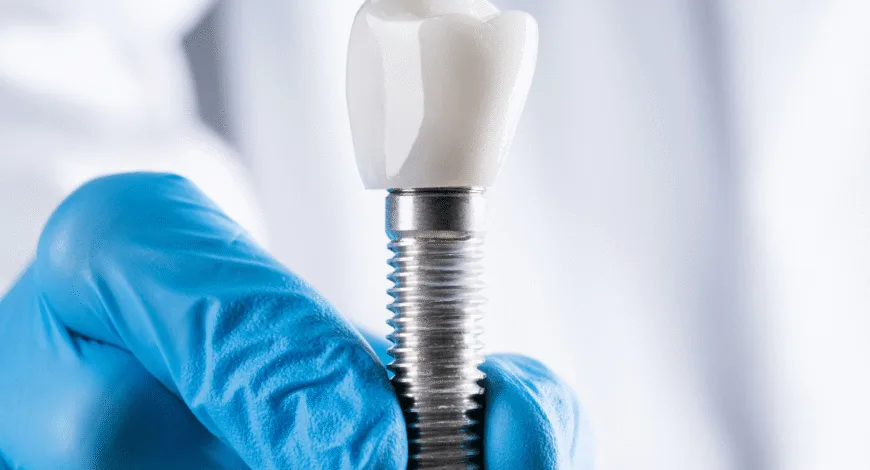After your dental implant surgery, you will leave the clinic with a new foundation for your smile and a list of post-operative instructions. These instructions—covering everything from diet to oral hygiene—are meticulously designed to ensure your recovery is as smooth, swift, and comfortable as possible.
Among these rules, one often seems surprisingly specific and sometimes puzzling to patients: “Do not use a straw.” This can lead to the very practical question, “For how long?”
The standard recommendation from most oral surgeons and implant specialists is that you should avoid using a straw for at least one week (7 days) after your dental implant surgery. Depending on the complexity of your procedure, some surgeons may advise waiting even longer, up to two weeks.
This simple rule is not an arbitrary precaution. It is a critical medical instruction directly linked to protecting the fragile healing environment in your mouth. The gentle suction you create when using a straw is surprisingly powerful, and it can disrupt the single most important element of your post-operative healing: the blood clot.
This comprehensive guide will provide a deep dive into the science behind this crucial rule. We will explain the vital role of the blood clot, the painful complication you are trying to avoid, a clear timeline for your recovery, and other activities you should steer clear of to protect your significant investment.
The Hero of Healing: Understanding the Importance of the Blood Clot
To understand why straws are forbidden, you must first appreciate the hero of the healing process: the blood clot.
Immediately after your dental implant is placed, the surgical site (the osteotomy) fills with blood. This blood quickly coagulates to form a stable clot. This is not just a simple plug to stop the bleeding; it is a complex and vital biological bandage that serves several critical functions:
- It Protects the Surgical Site: The clot forms a protective barrier over the underlying jawbone and sensitive nerve endings, shielding them from air, food, saliva, and bacteria.
- It Provides a Scaffold for Healing: The blood clot is rich in platelets and growth factors. It creates the perfect natural “scaffold” or matrix upon which all new tissue growth will occur. Cells that form new gum tissue and, eventually, new bone will migrate into this clot as the foundation for their work.
- It Reduces Pain: By covering the exposed bone and nerves, a healthy blood clot significantly reduces post-operative pain and sensitivity.
In short, the formation and preservation of a stable blood clot is the absolute cornerstone of a successful and comfortable healing process. Anything that threatens this clot threatens your recovery.
The Villain of the Story: The Dangers of Suction and Dry Socket
The primary villain that threatens the blood clot is suction.
When you drink from a straw, you create a negative pressure, or a vacuum, in your mouth to draw the liquid up. This seemingly gentle force is often more than enough to dislodge, or literally suck, the delicate blood clot right out of the socket.
When the blood clot is lost prematurely, it leads to a notoriously painful complication called Alveolar Osteitis, more commonly known as Dry Socket.
What is a Dry Socket? A dry socket is a condition where the underlying bone and nerve endings are left exposed after the protective blood clot has been dislodged. Without this protective layer, the site becomes incredibly vulnerable to irritation and infection.
Symptoms of a Dry Socket:
- Severe, Throbbing Pain: This is the hallmark symptom. The pain is not the typical post-operative soreness; it is an intense, deep, and often radiating pain that can travel to your ear, eye, or temple. It usually begins 2 to 4 days afterthe surgery.
- Visible Empty Socket: You may be able to see the exposed, whitish jawbone in the surgical site instead of a dark, healing blood clot.
- A Foul Taste or Bad Odor: An unpleasant taste or smell can emanate from the socket.
A dry socket is a significant setback in your healing journey. It is not only extremely painful but requires additional visits to your dentist for treatment, which typically involves flushing the socket and placing a medicated dressing to soothe the exposed bone and promote healing.
The “no straw” rule is the simplest and most effective way to prevent this agonizing complication.
Beyond Straws: Other “Suction” Activities You Must Avoid
The risk is not from the straw itself, but from the vacuum it creates. Therefore, you must also avoid several other common activities that produce a similar negative pressure in your mouth during the first week of healing.
- Smoking or Vaping: This is the number one risk factor for developing a dry socket. The forceful sucking action is a direct threat to the blood clot. Furthermore, the hundreds of chemicals in cigarette smoke, as well as the heat and nicotine, severely impair blood flow, suppress the immune system, and can kill off the new cells that are trying to heal the area.
- Vigorous Rinsing or Spitting: Forcefully swishing liquid around your mouth or spitting it out can easily dislodge the clot. When you rinse, do so very gently. Instead of spitting, simply open your mouth over the sink and let the liquid fall out.
- Using a Water Flosser: While a great tool for long-term implant care, do not aim a water flosser at or near the surgical site for several weeks until your dentist gives you clearance.
- Playing a Wind Instrument: Instruments like a trumpet, saxophone, or even a flute require pressure and oral muscle control that can disrupt the healing site.
The Official Timeline: A Guide to Your First Weeks of Recovery
Here is a general timeline to help you understand the “no straw” rule within the broader context of your recovery.
Day 1-3: The Critical Phase This is when the blood clot is at its most fragile.
- Diet: Stick to a liquid or very soft, no-chew diet. Think smoothies (eaten with a spoon), yogurt, soup, and mashed potatoes.
- Activities: Focus on rest. Avoid all suction activities without exception—no straws, no smoking.
- Oral Hygiene: Brush your other teeth carefully, avoiding the surgical site. Use a prescribed antimicrobial rinse as directed, but let it fall gently from your mouth.
Day 4-7: The Stabilization Phase The blood clot is becoming more stable, but it is still vulnerable.
- Diet: You can begin to introduce more substantial soft foods, like scrambled eggs, pasta, and soft fish.
- Activities: Continue to strictly avoid straws and all other suction activities.
- Oral Hygiene: You can begin to gently clean around the surgical area as instructed by your surgeon. Continue with your gentle rinses.
After Day 7 (Week 2): The Transition Phase By the end of the first week, the initial layer of new gum tissue has begun to form over the blood clot, making it much more secure.
- For a simple, single implant placement: Most surgeons will give you clearance to cautiously resume using a straw at this point.
- For complex procedures: If your surgery was more extensive and involved significant bone grafting or a sinus lift, the healing area is larger and more delicate. In these cases, your surgeon will likely recommend you wait a full two weeks (14 days) or even longer before using a straw.
The Golden Rule: When in Doubt, Ask Your Surgeon! This timeline is excellent general guidance. However, your surgeon knows the specifics of your procedure. Always adhere to the personalized post-operative instructions they provide. If you are unsure about a specific activity, a quick phone call to your dental clinic is the smartest thing you can do.
Top Searched FAQs About Post-Implant Aftercare
1. What happens if I accidentally used a straw once after my surgery? Don’t panic. A single, gentle sip may not necessarily dislodge the clot. The key is to stop immediately and monitor the area. If you do not experience increased bleeding or a sudden onset of severe pain in the coming days, you are likely fine. Avoid all straws from that point on.
2. How am I supposed to drink without a straw? For the first week, you will need to drink directly from a glass or cup. Do so slowly and carefully, especially on the first day, as your mouth may still be partially numb.
3. When can I drink carbonated beverages or hot coffee? It’s best to avoid carbonated drinks for the first few days, as the fizz can irritate the fresh wound. Hot beverages like coffee or tea should also be avoided for the first 24-48 hours, as the heat can dissolve the blood clot and increase bleeding. Opt for lukewarm or cool drinks instead.
4. What are the very first signs of a dry socket? The hallmark sign is a sudden increase in intense, throbbing pain beginning on the second, third, or fourth day after your surgery, at a time when you should be starting to feel better. This is often accompanied by a bad taste or odor. If you experience this, call your dentist immediately.
Conclusion: A Simple Rule for a Priceless Investment
Your new dental implant is designed to be a permanent, lifelong solution. The success of this remarkable technology is built upon a foundation of healthy, uninterrupted healing. Following the simple but crucial rule of avoiding straws—and all other forms of suction—for at least one week after your surgery is one of the most important things you can do to protect that foundation.
It is a small, temporary adjustment to your habits that prevents an extremely painful complication, promotes faster and more comfortable healing, and ensures the long-term success of your incredible investment.

